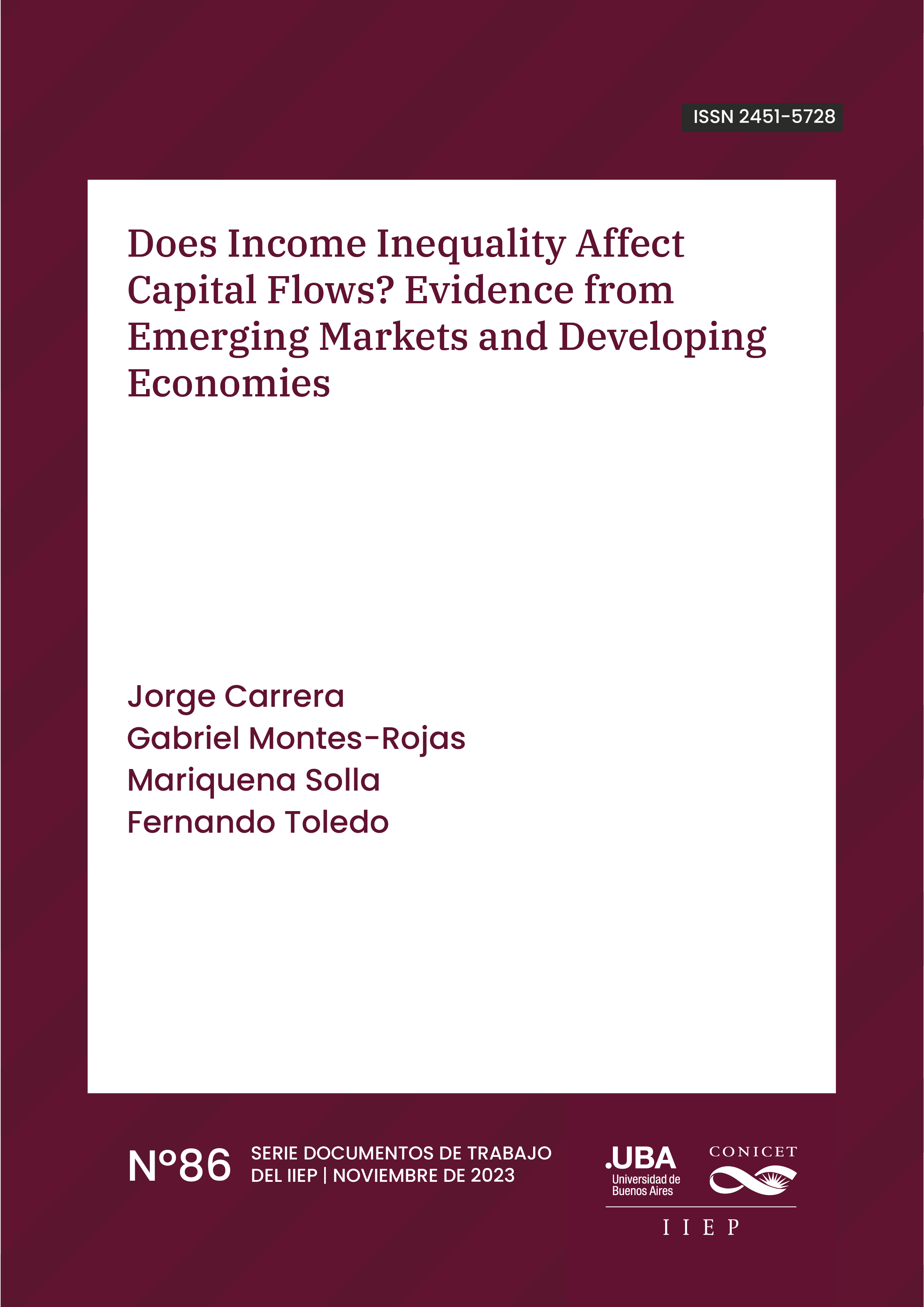La desigualdad de ingresos afecta los flujos de capitales? Evidencia de Economías Emergentes y en Desarrollo
Resumen
Diferenciamos entre entradas y salidas de capital agregado (acumulación de pasivos externos) y salidas (acumulación de activos externos) y entradas y salidas de capital público y privado desagregadas. Estimamos modelos de datos de panel dinámicos utilizando observaciones anuales para Mercados emergentes y economías en desarrollo durante el período 1999-2019. Encontramos que las medidas de desigualdad Top 1 y Top 10 son positivas y estadísticamente significativas para las entradas agregadas y privadas, y que el ingreso disponible de Gini es estadísticamente significativo solo para un método explorado. La evidencia también muestra que hay un efecto débil sobre las salidas de capitales privados, sólido en todos los métodos sólo en la especificación agregada. Los resultados también sugieren que la apertura financiera se asocia positivamente con un mayor efecto de desigualdad.
Citas
Arellano, M. & Bond, S. (1991). “Some Tests of Specification for Panel Data: Monte Carlo Evidence and an Application to Employment Equations”, Review of Economic Studies, 58(2): 277-297.
Avdjiev, S., Hardy, B., Kalemli-Özcan, Ş. & Servén, L. (2022). “Gross Capital Flows by Banks, Corporates, and Sovereigns”, Journal of the European Economic Association, 20: 2098-2135.
Azzimonti, M., de Francisco, E. & Quadrini, V. (2014). “Financial Globalization, Inequality, and the Rising Public Debt”, American Economic Review, 104(8): 2267-2302.
Blundell, R. & Bond, S. (1998). “Initial conditions and moment restrictions in dynamic panel data models”, Journal of Econometrics (1998): 115-143.
Bruno, F. (2005). “Estimation and inference in dynamic unbalanced panel-data models with a small number of individuals”, Stata Journal, 5(4): 473–500.
Bun, M. & Kiviet, J. (2006). “The effects of dynamic feedbacks on LS and MM estimator accuracy in panel data models”, Journal of Econometrics, 132(2): 409-444.
Caballero, R. & Krishnamurthy, A. (2009). “Global Imbalances and Financial Fragility”, American Economic Review, 99(2): 584-588.
Carrera, J., de la Vega, P. & Toledo, F. (2023). “Income inequality and fiscal policy over the political cycle”, forthcoming Empirical Economics (published: 19 June 2023): https://doi.org/10.1007/s00181-023-02455-1
Corneo, G. (2016). “Inequality, Public Wealth, and the Federal Shareholder”, IZA Policy Paper No. 115.
Gourinchas, P.-O. & Rey, H. (2007). “International Financial Adjustment”, Journal of Political Economy, 115(4): 665-703.
Hannan, S. (2018). “Revisiting the Determinants of Capital Flows to Emerging Markets—A Survey of the Evolving Literature”, IMF Working Paper 18/214, International Monetary Fund, Washington, D.C.
Ilzetzki, E., Reinhart, C. & Rogoff, K. (2019). “Exchange Arrangements Entering the 21st Century: Which Anchor Will Hold?”, Quarterly Journal of Economics, 134(2): 599-646.
Kemme, D., Parikh, B. & Steigner, T. (2021). “Inequality, autocracy, and sovereign funds as determinants of foreign portfolio equity flows”, The Journal of Financial Research, 44(2): 249-278.
Kumhof, M., R., Lebarz, C., Rancière, N., Richter, A. & Throckmorton, C. (2012). “Income Inequality and Current Account Imbalances”, IMF Working Paper 12/8, International Monetary Fund, Washington, D.C.
Lane, P. & Milesi-Ferretti, G. (2007). “The external wealth of nations mark II: Revised and extended estimates of foreign assets and liabilities, 1970–2004”, Journal of International Economics, 73(2): 223-250.
Ortiz, I., Cummins, M. & Karunanethy, K. (2017). “Fiscal Space for Social Protection and the SDGs. Options to Expand Social Investments in 187 countries”, Extension of Social Security Working Paper 048, ILO, UNICEF, and UNWOMEN.
Roodman, D. (2009a). “A Note on the Theme of Too Many Instruments”, Oxford Bulletin of Economics and Statistics, 71(1): 135-158.
----. (2009b). “How to do xtabond2: An Introduction to Difference and System GMM in Stata”, Stata Journal, 9(1): 86-136.




